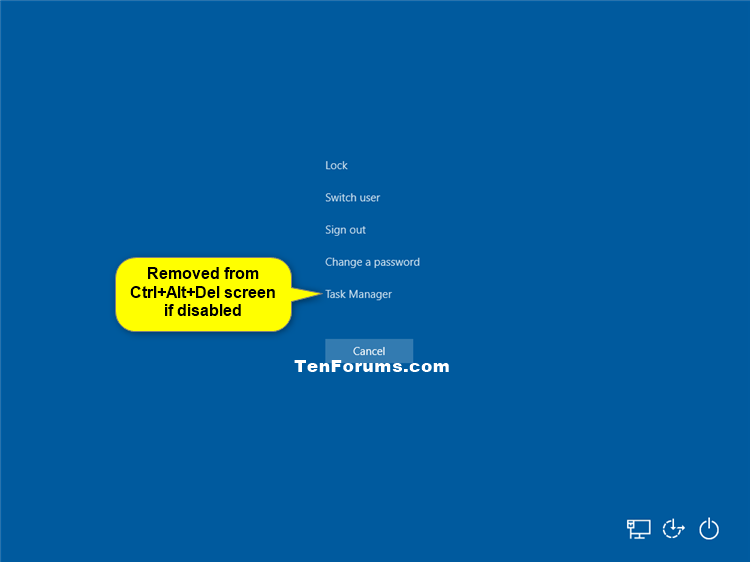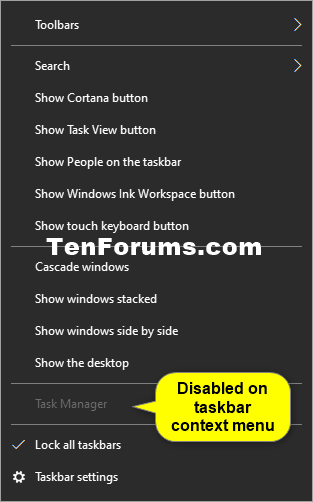How to Enable or Disable Task Manager in Windows 10
Task Manager can be used to view and manage your processes, performance statistics, app history, users, processes details, and services in Windows 10.
This tutorial will show you how to enable or disable Task Manager for all or specific users in Windows 7, Windows 8, and Windows 10.
You must be signed in as an administrator to enable or disable Task Manager.
Contents
- Option One: Enable or Disable Task Manager for All or Specific Users in Local Group Policy Editor
- Option Two: Enable or Disable Task Manager for All Users using a REG file
EXAMPLE: Task Manager in Windows 10
EXAMPLE: Task Manager disabled

In Windows 7, the Local Group Policy Editor is only available in the Professional, Ultimate, and Enterprise editions.
In Windows 8, the Local Group Policy Editor is only available in the Pro and Enterprise editions.
In Windows 10, the Local Group Policy Editor is only available in the Pro, Enterprise, and Education editions.
All editions can use Option Two.
1 Open the Local Group Policy Editor.
2 Navigate to the policy folder location below in the left pane of the Local Group Policy Editor. (see screenshot below)
User Configuration\Administrative Templates\Ctrl+Alt+Del Options
3 In the right pane of Ctrl+Alt+Del Options, double click/tap on the Remove Task Manager policy to edit it. (see screenshot above)
4 Do step 5 (enable) or step 6 (disable) below for what you would like to do.
A) Select (dot) either Not Configured or Disabled, click/tap on OK, and go to step 7 below. (see screenshot below)
Not Configured is the default setting.
7 When finished, you can close Local Group Policy Editor if you like.
The downloadable .reg files below will add and modify the DWORD value in the registry keys below.
HKEY_CURRENT_USER\SOFTWARE\Microsoft\Windows\CurrentVersion\Policies\System
HKEY_LOCAL_MACHINE\SOFTWARE\Microsoft\Windows\CurrentVersion\Policies\System
DisableTaskMgr DWORD
(delete) = Enable
1 = Disable
1 Do step 2 (enable) or step 3 (disable) below for what you would like to do.
This is the default setting
A) Click/tap on the Download button below to download the file below, and go to step 4 below.
Enable_Task_Manager_for_all_users.reg
Download
A) Click/tap on the Download button below to download the file below, and go to step 4 below.
Disable_Task_Manager_for_all_users.reg
Download
4 Save the .reg file to your desktop.
5 Double click/tap on the downloaded .reg file to merge it.
6 When prompted, click/tap on Run, Yes (UAC), Yes, and OK to approve the merge.
7 You can now delete the downloaded .reg file if you like.
That's it,
Shawn
Related Tutorials
- How to Open Task Manager in Windows 10
- How to Reset Task Manager to Default in Windows 10
- How to Turn On or Off Always On Top for Task Manager in Windows 10
- How to Backup and Restore Task Manager Settings in Windows 10
- How to Add or Remove Details in Task Manager in Windows 10
- How to Enable Set Default Tab Feature for Task Manager in Windows 10
- How to Set Default Tab for Task Manager in Windows 10
- How to View Power Usage of Processes in Task Manager in Windows 10
- How to Toggle Graph Summary View On or Off in Windows 10 Task Manager
- How to Toggle Summary View On or Off in Windows 10 Task Manager
- How to Turn On or Off Hide Task Manager Taskbar Icon when Minimized in Windows 10
- How to Turn On or Off Minimize on use for Task Manager in Windows 10
- How to Change Data Update Speed in Task Manager in Windows 10
- How to Monitor GPU Temperature from Task Manager in Windows 10
- How to See Startup Impact of Startup Apps in Windows 8 and Windows 10
How to Enable or Disable Task Manager in Windows 10

How to Enable or Disable Task Manager in Windows 10
Published by Shawn BrinkCategory: General Tips24 Feb 2020
Tutorial Categories


Related Discussions







